Coat of arms of France: Difference between revisions
| Line 87: | Line 87: | ||
| caption1 = The arms adorning the entrance of the [[Ministry of Europe and Foreign Affairs|Foreign Ministry]] (37 [[Quai d'Orsay]]) on the 1905 Spanish royal visit. |
| caption1 = The arms adorning the entrance of the [[Ministry of Europe and Foreign Affairs|Foreign Ministry]] (37 [[Quai d'Orsay]]) on the 1905 Spanish royal visit. |
||
| image2 = |
| image2 = Médaille de la Fidélité Française (reverse).png |
||
| caption2 = The arms emblazoned onto the reverse side of the [[:fr:Médaille de la Fidélité Française|Medal for Fidelity to France]], instituted in 1922 |
|||
| ⚫ | | |
||
| image3 = |
| image3 = 1952 Trygve Lie Resigns.jpg |
||
| ⚫ | | caption3 = [[Escutcheon (heraldry)|Escutcheons]] in the [[United Nations General Assembly|UNGA]] hall intended to be emblazoned with national arms, including France's.<ref>https://www.unmultimedia.org/s/photo/detail/704/0070477.html</ref>, but removed in 1956.<ref>https://fotw.info/flags/fr).html</ref><ref>https://www.unmultimedia.org/s/photo/detail/783/0078376.html</ref> |
||
| ⚫ | |||
| image4 = Visites Sarkozy Hollande à l'hôtel de ville de Paris.jpg |
|||
| ⚫ | |||
| image4 = Parione - s Nicola dei Lorenesi fascio repubblicano francese P1030725.JPG |
| image4 = Parione - s Nicola dei Lorenesi fascio repubblicano francese P1030725.JPG |
||
Revision as of 19:39, 1 December 2020
| Coat of arms of France | |
|---|---|
 | |
| Versions | |
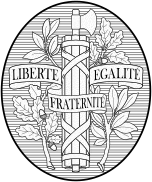 Monochrome (hatched) version | |
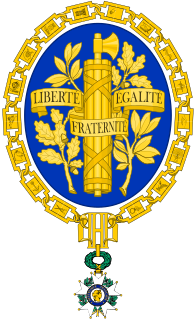 | |
| Armiger | French Republic[3] |
| Adopted | 1905 (1953 with present collar)[4] |
| Crest | Wreath |
| Shield | Azure, a lictor's fasces palewise upon two branches, of oak and of laurel, crossed in saltire, all or, surmounted by a ribbon of the same charged with the motto in letters sable: "LIBERTÉ, ÉGALITÉ, FRATERNITÉ" |
| Supporters | Angels |
| Compartment | Wheat, weapons, flowers and musical instruments |
| Order(s) | Collar of the Legion of Honour (1953 version) |
| Other elements | All surrounded by wheat mantling, Cockade of France, Flag of France, flowers |
The coat of arms of France depicts a lictor's fasces surrounded by branches of laurel and oak, as well as a ribbon bearing the national motto Liberté, égalité, fraternité. Introduced in 1905, this heraldic emblem has been used by the third, fourth and (present) fifth republic. In 1953, a new grand collar was introduced for the Legion of Honour, replacing the previous 1881 version included in the heraldic achievement.
Devices
Azure, a lictor's fasces palewise upon two branches, of oak and of laurel, crossed in saltire, all or, surmounted by a ribbon of the same charged with the motto in letters sable: "LIBERTÉ, ÉGALITÉ, FRATERNITÉ". The shield is surrounded by the Grand Collar of the Order of the Legion of Honor proper, the cross suspended from it in base.
Coat of arms: Charges
Motto
Liberté, égalité, fraternité (French pronunciation: [libɛʁte eɡalite fʁatɛʁnite]; "liberty, equality, fraternity",[6] is the national motto of France, and is an example of a tripartite motto. Although it finds its origins in the French Revolution, it was then only one motto among others and was not institutionalized until the Third Republic at the end of the 19th century.[7]
Fasces
Fasces are a bundle of birch rods containing a sacrificial axe. In Roman times, the fasces symbolized the power of magistrates, representing union and accord with the Roman Republic. French architects began to use the Roman fasces (faisceaux romains) as a decorative device during the reign of Louis XIII (1610–1643)[8][9], and the imagery of the French Revolution used references to the ancient Roman Republic to an even greater extent. During the First Republic, topped by the Phrygian cap, the fasces is a tribute to the Roman Republic and means that power belongs to the people. It also symbolizes the "unity and indivisibility of the Republic",[10] as stated in the French Constitution.
Branches
- The oak is France's national tree, and a common symbol of strength and endurance.[11]
- A bay laurel (Laurus nobilis) branch, an aromatic broadleaf evergreen, or later from spineless butcher's broom (Ruscus hypoglossum) or cherry laurel (Prunus laurocerasus). It is a symbol of triumph, which traces back to Greek mythology. Apollo is represented wearing a laurel wreath on his head, and wreaths were awarded to victors in athletic competitions, including the ancient Olympics — for which they were made of wild olive-tree known as "kotinos" (κότινος),[12] (sc. at Olympia)—and in poetic meets. In Rome they were symbols of martial victory, crowning a successful commander during his triumph.
External devices
| External image | |
|---|---|
- Star and grand collar of the Legion of Honour, which is the highest French order of merit for military and civil merits, established in 1802 by Napoleon Bonaparte and retained by all later French governments and régimes. The achievement includes the order's grand collar, which is worn only by the President, as Grand Master of the order.
-
1953 version of the grand collar
In 1925, a greater version of the arms (achievement) was depicted on a painted tapestry in the Art Deco style by Gustave Louis Jaulmes, titled "Les armes de France". Commissioned by the city of Strasbourg,[13] this piece was to be installed at the Commissariat General of the Republic in the city.
In addition to the escutcheon and order (which had already been introduced in 1905), it depicts other external devices, including:
- A compartment made of wheat, weapons, flowers and musical instruments
- Two angelic supporters
- All surrounded by wheat mantling, Cockade of France, Flag of France, flowers
- Laurel wreath crest
- Achievements including the 1881 version of the grand collar, as used until 1953
-
Lesser version
-
Greater version (1925)
History
Timeline of usage
- 1905: The arms was introduced as a national symbol at the occasion of King Alfonso XIII's official visit to France. It was displayed on the steps of the king's residence and at the French foreign ministry.[17][18]
- 1922: The arms was emblazoned on the Medal for Fidelity to France (French: Médaille de la Fidélité Française), awarded to inhabitants of the two border regions of Alsace and Lorraine, who had been either imprisoned or exiled by the occupying Germans during World War I because of their loyalty to France.[19]
- 1924/1925: A greater version of the arms was depicted on a painted tapestry by Gustave Louis Jaulmes, titled "Les armes de France". Commissioned by the city of Strasbourg,[20] this piece was to be installed at the Commissariat General of the Republic in the city.
- 1928: German encyclopedias gave a color reproduction of Jaulmes' greater arms.
- 1929: On 10 May the German embassy in France inquired what was the official coat of arms of France was. The French Ministry of Foreign Affairs replied that "there is no, in principle, official coat of arms or emblem," but that such a composition was used for the French embassies and consulates.
- 1935: The annual edition of Le Petit Larousse reproduced a monochrome reproduction of the arms as a symbol of the French Republic.
- 1953: The United Nations Secretariat requested that France submit a national coat of arms that were to adorn the wall behind the podium in the General Assembly hall in New York, alongside the other member states' arms. On 3 June, an interministerial commission met at the Ministry of Foreign Affairs to select this emblem. It requested Robert Louis (1902–1965), heraldic artist, to produce a version of the Jules-Clément Chaplain design. In the end, Louis chose the 1905 design and this was submitted.
- 1975: President Valéry Giscard d'Estaing adopted the charge of the arms in his presidential standard.
- 6 June 1980: President d'Estaing assumed on him being admitted to the Order of the Seraphim: Azure a Fasces Or bindings Argent between two Laurel sprigs disposed orleways of the second and bound together in base by a ribbon of the third., based on the republican arms.
- 2009: Used to represent France in the Hanseatic Fountain in Veliky Novgorod, Russia.[21]
The coat of arms is still used, e.g. in relation to presidential inaugurations, including that of François Mitterrand, Jacques Chirac and Emmanuel Macron in 1981, 1995 and 2017, respectively.[22][23]
Previous designs
The present arms follows the fleur-de-lis designs used by French kings since the Middle Ages, which were followed by the Napoleonic eagle designs after the French Revolution. The fleur-de-lis is still popular, and used by overseas people of French heritage, like the Acadians, Québécois or Cajuns.
| Period | Dates used | Coat of arms | Achievement | Banner of arms | Description and blazon |
|---|---|---|---|---|---|
| Kingdom | Before 1305 | 
|

|

|
The arms of France Ancient: Azure semé-de-lis or The historical coat of arms of France were the golden fleurs-de-lys on a blue field, used continuously for nearly six centuries (1211–1792). Although according to legend they originated at the baptism of Clovis, who supposedly replaced the three toads that adorned his shield with three lilies given by an angel, they are first documented only from the early 13th century. They were first shown as semé, that is to say without any definite number and staggered (known as France ancient), but in 1376 they were reduced to three, (known as France modern). With this decision, King Charles V intended to place the kingdom under the double invocation of the Virgin (the lily is a symbol of Mary), and the Trinity, for the number. The traditional supporters of the French royal arms are two angels, sometimes wearing a heraldic dalmatic. |
| 1305–1328 | 
|

|

|
Arms of France Ancient dimidiated with the arms of Navarre, after king Louis X inherited Navare from his mother Joan I of Navarre in 1305. | |
| 1328–1376 | 
|

|

|
The arms of France Ancient: Azure semé-de-lis or. After the death of the last direct Capetian in 1328, the kingdom of France passed to the house of Valois through the Salic law, and Navarre passed to the house of Evreux through female line. | |
| 1376–1469 | 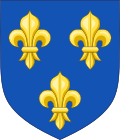
|
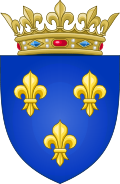
|

|
The arms of France Modern: Azure, three fleurs-de-lis or, a simplified version of France Ancient | |
| 1469–1515 | 
|
The arms of France Modern. After the creation of the Order of Saint Michael in 1469, its collar was added to the royal arms. | |||
| 1515–1578 | 
|
The arms of France Modern. King Francis I changed the open crown traditionally used by his predecessors for a closed one. | |||
| 1578–1589 | 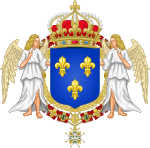
|
The arms of France Modern. After the creation of the Order of the Holy Spirit in 1578, its collar was added to the royal arms. | |||
| 1589–1792 | 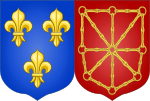
|

|
The royal arms of the Kingdom of France after the conclusion of the French Wars of Religion. Again the arms of the Kingdom of Navarre impaled with France Moderne, indicating the personal union of the two realms as a result of Henry IV becoming king. | ||
| First Republic | 1791–1804 | 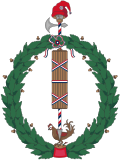
|

|

|
Putative heraldic emblem of the First French Republic |
| First Empire | 1804–1814/1815 | 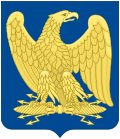
|

|

|
The arms of the First French Empire of Napoleon I, featuring an eagle, the Crown of Napoleon and inset with "golden bees" as in the tomb of King Childeric I. |
| Kingdom (Bourbon Restoration) | 1814/1815–1830 | 
|

|

|
After the Bourbon Restoration, the royal House of Bourbon once more assumed the French crown. |
| Kingdom (July Monarchy) | 1830–1831 | 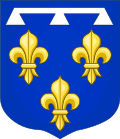
|
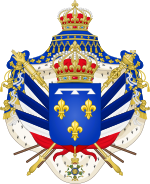
|

|
During the July Monarchy, the arms of the House of Orléans were used. |
| 1831–1848 | 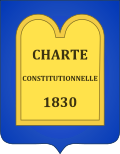
|

|

|
From 1831 onward, the arms of Louis-Philippe were used, depicting the Charter of 1830. (Stars were eventually added to the Mantling; along with addition of Supporters, a decrease of the flags to two, the addition of a helmet, the reversion to the Fleur-de-Lys Crown as one of the two Crowns, the flagpoles having spearheads and at the base were two cannons surmounted by floral branches.) | |
| Second Empire | 1852–1870 | 
|

|

|
The arms of the Second French Empire of Napoleon III, again featuring an eagle, but now with the Crown of Napoleon III. |
Examples of emblazonment
There are many and varied examples of emblazonment, such as:
-
Bust of Charlemagne (1349)
-
Caparison and banners (c. 1455)
-
Tent (15th century)
-
Baldachin (2010)
-
Ceiling (2018)
-
Grand Constable of France's scabbard
See also
- Armorial of France
- Armorial of presidents of France
- Armorial of the Capetian dynasty
- National symbols of France
- Symbolism in the French Revolution
References
- ^ http://www.hubert-herald.nl/FranFrance.htm
- ^ https://www.max-gueguen.com/reception-demmanuel-macron-a-lhotel-de-ville-de-paris/
- ^ https://www.max-gueguen.com/reception-demmanuel-macron-a-lhotel-de-ville-de-paris/
- ^ "Les symboles de la République française". Site de la présidence de la République.
- ^ https://www.fotw.info/flags/fr).html#sym
- ^ "Liberty, Égalité, Fraternité". Embassy of France in the US. Archived from the original on 18 October 2014. Retrieved 18 September 2014.
- ^ Ozouf, Mona (1997), "Liberté, égalité, fraternité stands for peace country and war", in Nora, Pierre (ed.), Lieux de Mémoire [Places of memory] (in French), vol. tome III, Quarto Gallimard, pp. 4353–89 (abridged translation, Realms of Memory, Columbia University Press, 1996–98).
- ^ Les Grands Palais de France : Fontainebleau, I re Série, Styles Louis XV, Louis XVI, Empire, Labrairie Centrale D'Art Et D'Architecture, Ancienne Maison Morel, Ch. Eggimann, Succ, 106, Boulevard Saint Germain, Paris, 1910
- ^ Les Grands Palais de France : Fontainebleau , II me Série, Les Appartments D'Anne D'Autriche, De François I er, Et D'Elenonre La Chapelle, Labrairie Centrale D'Art Et D'Architecture, Ancienne Maison Morel, Ch. Eggimann, Succ, 106, Boulevard Saint Germain, Paris, 1912
- ^ Site of the French Presidency Archived November 4, 2012, at the Wayback Machine
- ^ "Oak as a Symbol". Venables Oak. Archived from the original on 5 May 2013. Retrieved 26 September 2012.
- ^ Liddell, Henry George; Scott, Robert (1843). A Greek-English Lexicon (1 ed.). Oxford: Oxford University Press. ISBN 978-0-19-864226-8. Retrieved 13 February 2019.
κότι^νος
- ^ https://agorha.inha.fr/inhaprod/ark:/54721/00278365
- ^ https://www.unmultimedia.org/s/photo/detail/704/0070477.html
- ^ https://fotw.info/flags/fr).html
- ^ https://www.unmultimedia.org/s/photo/detail/783/0078376.html
- ^ http://www.hubert-herald.nl/FranFrance.htm
- ^ https://bibliotheques-specialisees.paris.fr/ark:/73873/pf0001198956/0066/v0001.simple.selectedTab=otherdocs.hidesidebar
- ^ http://www.gwpda.org/medals/frenmedl/france.html
- ^ https://agorha.inha.fr/inhaprod/ark:/54721/00278365
- ^ https://www.123rf.com/photo_44472384_veliky-novgorod-russia-august-17-2015-coat-of-arms-of-france-represented-in-the-hanseatic-fountain-t.html
- ^ https://www.max-gueguen.com/reception-demmanuel-macron-a-lhotel-de-ville-de-paris/
- ^ File:Visites Mitterrand Chirac à l'hôtel de ville de Paris.jpg
External links
- Symbols of France at Flags of the World
- France at Heraldry of the World
- Heraldry of France — Hubert de Vries website
- Les Armes de Strasbourg — Collection du Mobilier national (in French)
- http://www.languedoc-france.info/06141203_motto.htm
- http://svowebmaster.free.fr/blason_france.html

















